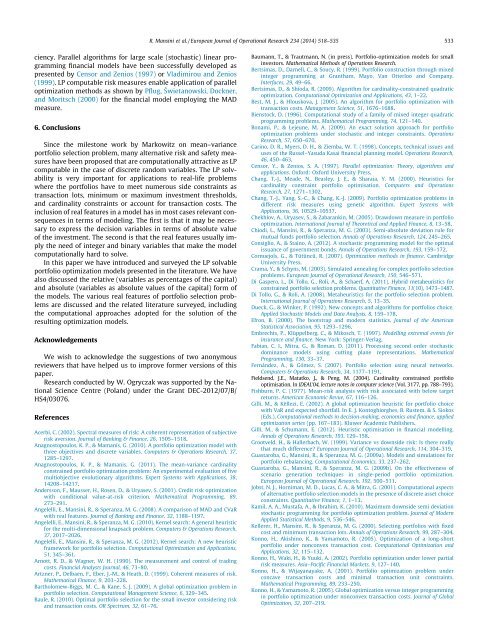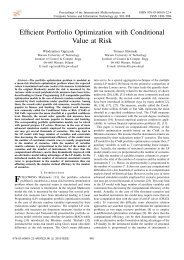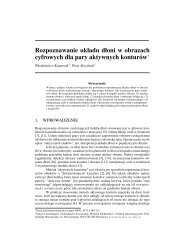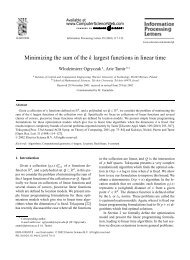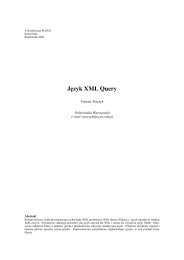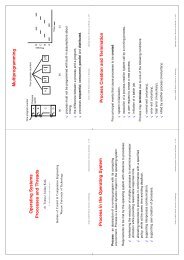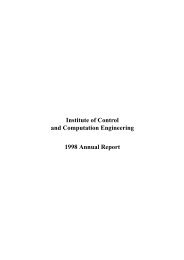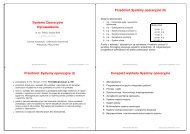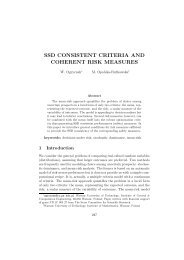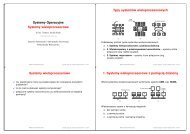Twenty Years of Linear Programming Based Portfolio Optimization
Twenty Years of Linear Programming Based Portfolio Optimization
Twenty Years of Linear Programming Based Portfolio Optimization
You also want an ePaper? Increase the reach of your titles
YUMPU automatically turns print PDFs into web optimized ePapers that Google loves.
R. Mansini et al. / European Journal <strong>of</strong> Operational Research 234 (2014) 518–535 533<br />
ciency. Parallel algorithms for large scale (stochastic) linear programming<br />
financial models have been successfully developed as<br />
presented by Censor and Zenios (1997) or Vladimirou and Zenios<br />
(1999). LP computable risk measures enable application <strong>of</strong> parallel<br />
optimization methods as shown by Pflug, Świetanowski, Dockner,<br />
and Moritsch (2000) for the financial model employing the MAD<br />
measure.<br />
6. Conclusions<br />
Since the milestone work by Markowitz on mean–variance<br />
portfolio selection problem, many alternative risk and safety measures<br />
have been proposed that are computationally attractive as LP<br />
computable in the case <strong>of</strong> discrete random variables. The LP solvability<br />
is very important for applications to real-life problems<br />
where the portfolios have to meet numerous side constraints as<br />
transaction lots, minimum or maximum investment thresholds,<br />
and cardinality constraints or account for transaction costs. The<br />
inclusion <strong>of</strong> real features in a model has in most cases relevant consequences<br />
in terms <strong>of</strong> modeling. The first is that it may be necessary<br />
to express the decision variables in terms <strong>of</strong> absolute value<br />
<strong>of</strong> the investment. The second is that the real features usually imply<br />
the need <strong>of</strong> integer and binary variables that make the model<br />
computationally hard to solve.<br />
In this paper we have introduced and surveyed the LP solvable<br />
portfolio optimization models presented in the literature. We have<br />
also discussed the relative (variables as percentages <strong>of</strong> the capital)<br />
and absolute (variables as absolute values <strong>of</strong> the capital) form <strong>of</strong><br />
the models. The various real features <strong>of</strong> portfolio selection problems<br />
are discussed and the related literature surveyed, including<br />
the computational approaches adopted for the solution <strong>of</strong> the<br />
resulting optimization models.<br />
Acknowledgements<br />
We wish to acknowledge the suggestions <strong>of</strong> two anonymous<br />
reviewers that have helped us to improve former versions <strong>of</strong> this<br />
paper.<br />
Research conducted by W. Ogryczak was supported by the National<br />
Science Centre (Poland) under the Grant DEC-2012/07/B/<br />
HS4/03076.<br />
References<br />
Acerbi, C. (2002). Spectral measures <strong>of</strong> risk: A coherent representation <strong>of</strong> subjective<br />
risk aversion. Journal <strong>of</strong> Banking & Finance, 26, 1505–1518.<br />
Anagnostopoulos, K. P., & Mamanis, G. (2010). A portfolio optimization model with<br />
three objectives and discrete variables. Computers & Operations Research, 37,<br />
1285–1297.<br />
Anagnostopoulos, K. P., & Mamanis, G. (2011). The mean-variance cardinality<br />
constrained portfolio optimization problem: An experimental evaluation <strong>of</strong> five<br />
multiobjective evolutionary algorithms. Expert Systems with Applications, 38,<br />
14208–14217.<br />
Andersson, F., Mausser, H., Rosen, D., & Uryasev, S. (2001). Credit risk optimization<br />
with conditional value-at-risk criterion. Mathematical <strong>Programming</strong>, 89,<br />
273–291.<br />
Angelelli, E., Mansini, R., & Speranza, M. G. (2008). A comparison <strong>of</strong> MAD and CVaR<br />
with real features. Journal <strong>of</strong> Banking and Finance, 32, 1188–1197.<br />
Angelelli, E., Mansini, R., & Speranza, M. G. (2010). Kernel search: A general heuristic<br />
for the multi-dimensional knapsack problem. Computers & Operations Research,<br />
37, 2017–2026.<br />
Angelelli, E., Mansini, R., & Speranza, M. G. (2012). Kernel search: A new heuristic<br />
framework for portfolio selection. Computational <strong>Optimization</strong> and Applications,<br />
51, 345–361.<br />
Arnott, R. D., & Wagner, W. H. (1990). The measurement and control <strong>of</strong> trading<br />
costs. Financial Analysts Journal, 46, 73–80.<br />
Artzner, P., Delbaen, F., Eber, J.-M., & Heath, D. (1999). Coherent measures <strong>of</strong> risk.<br />
Mathematical Finance, 9, 203–228.<br />
Bartholomew-Biggs, M. C., & Kane, S. J. (2009). A global optimization problem in<br />
portfolio selection. Computational Management Science, 6, 329–345.<br />
Baule, R. (2010). Optimal portfolio selection for the small investor considering risk<br />
and transaction costs. OR Spectrum, 32, 61–76.<br />
Baumann, T., & Trautmann, N. (in press). <strong>Portfolio</strong>-optimization models for small<br />
investors. Mathematical Methods <strong>of</strong> Operations Research.<br />
Bertsimas, D., Darnell, C., & Soucy, R. (1999). <strong>Portfolio</strong> construction through mixed<br />
integer programming at Grantham, Mayo, Van Otterloo and Company.<br />
Interfaces, 29, 49–66.<br />
Bertsimas, D., & Shioda, R. (2009). Algorithm for cardinality-constrained quadratic<br />
optimization. Computational <strong>Optimization</strong> and Applications, 43, 1–22.<br />
Best, M. J., & Hlouskova, J. (2005). An algorithm for portfolio optimization with<br />
transaction costs. Management Science, 51, 1676–1688.<br />
Bienstock, D. (1996). Computational study <strong>of</strong> a family <strong>of</strong> mixed integer quadratic<br />
programming problems. Mathematical <strong>Programming</strong>, 74, 121–140.<br />
Bonami, P., & Lejeune, M. A. (2009). An exact solution approach for portfolio<br />
optimization problems under stochastic and integer constraints. Operations<br />
Research, 57, 650–670.<br />
Carino, D. R., Myers, D. H., & Ziemba, W. T. (1998). Concepts, technical issues and<br />
uses <strong>of</strong> the Russel–Yasuda Kasai financial planning model. Operations Research,<br />
46, 450–463.<br />
Censor, Y., & Zenios, S. A. (1997). Parallel optimization: Theory, algorithms and<br />
applications. Oxford: Oxford University Press.<br />
Chang, T.-J., Meade, N., Beasley, J. E., & Sharaia, Y. M. (2000). Heuristics for<br />
cardinality constraint portfolio optimisation. Computers and Operations<br />
Research, 27, 1271–1302.<br />
Chang, T.-J., Yang, S.-C., & Chang, K.-J. (2009). <strong>Portfolio</strong> optimization problems in<br />
different risk measures using genetic algorithm. Expert Systems with<br />
Applications, 36, 10529–10537.<br />
Chekhlov, A., Uryasev, S., & Zabarankin, M. (2005). Drawdown measure in portfolio<br />
optimization. International Journal <strong>of</strong> Theoretical and Applied Finance, 8, 13–58.<br />
Chiodi, L., Mansini, R., & Speranza, M. G. (2003). Semi-absolute deviation rule for<br />
mutual funds portfolio selection. Annals <strong>of</strong> Operations Research, 124, 245–265.<br />
Consiglio, A., & Staino, A. (2012). A stochastic programming model for the optimal<br />
issuance <strong>of</strong> government bonds. Annals <strong>of</strong> Operations Research, 193, 159–172.<br />
Cornuejols, G., & Tütüncü, R. (2007). <strong>Optimization</strong> methods in finance. Cambridge<br />
University Press.<br />
Crama, Y., & Schyns, M. (2003). Simulated annealing for complex portfolio selection<br />
problems. European Journal <strong>of</strong> Operational Research, 150, 546–571.<br />
Di Gaspero, L., Di Tollo, G., Roli, A., & Schaerf, A. (2011). Hybrid metaheuristics for<br />
constrained portfolio selection problems. Quantitative Finance, 11(10), 1473–1487.<br />
Di Tollo, G., & Roli, A. (2008). Metaheuristics for the portfolio selection problem.<br />
International Journal <strong>of</strong> Operations Research, 5, 13–35.<br />
Dueck, G., & Winker, P. (1992). New concepts and algorithms for portfolios choice.<br />
Applied Stochastic Models and Data Analysis, 8, 159–178.<br />
Efron, B. (2000). The bootstrap and modern statistics. Journal <strong>of</strong> the American<br />
Statistical Association, 95, 1293–1296.<br />
Embrechts, P., Klüppelberg, C., & Mikosch, T. (1997). Modelling extremal events for<br />
insurance and finance. New York: Springer-Verlag.<br />
Fabian, C. I., Mitra, G., & Roman, D. (2011). Processing second order stochastic<br />
dominance models using cutting plane representations. Mathematical<br />
<strong>Programming</strong>, 130, 33–37.<br />
Fernández, A., & Gómez, S. (2007). <strong>Portfolio</strong> selection using neural networks.<br />
Computers & Operations Research, 34, 1177–1191.<br />
Fieldsend, J.E., Matatko, J., & Peng, M. (2004). Cardinality constrained portfolio<br />
optimisation. In IDEAL’04, lecture notes in computer science (Vol. 3177, pp. 788–793).<br />
Fishburn, P. C. (1977). Mean-risk analysis with risk associated with below target<br />
returns. American Economic Revue, 67, 116–126.<br />
Gilli, M., & Këllezi, E. (2002). A global optimization heuristic for portfolio choice<br />
with VaR and expected shortfall. In E. J. Kontoghiorghes, B. Rustem, & S. Siokos<br />
(Eds.), Computational methods in decision-making, economics and finance, applied<br />
optimization series (pp. 167–183). Kluwer Academic Publishers.<br />
Gilli, M., & Schumann, E. (2012). Heuristic optimisation in financial modelling.<br />
Annals <strong>of</strong> Operations Research, 193, 129–158.<br />
Grootveld, H., & Hallerbach, W. (1999). Variance vs downside risk: Is there really<br />
that much difference? European Journal <strong>of</strong> Operational Research, 114, 304–319.<br />
Guastaroba, G., Mansini, R., & Speranza, M. G. (2009a). Models and simulations for<br />
portfolio rebalancing. Computational Economics, 33, 237–262.<br />
Guastaroba, G., Mansini, R., & Speranza, M. G. (2009b). On the effectiveness <strong>of</strong><br />
scenario generation techniques in single-period portfolio optimization.<br />
European Journal <strong>of</strong> Operational Research, 192, 500–511.<br />
Jobst, N. J., Horniman, M. D., Lucas, C. A., & Mitra, G. (2001). Computational aspects<br />
<strong>of</strong> alternative portfolio selection models in the presence <strong>of</strong> discrete asset choice<br />
constraints. Quantitative Finance, 1, 1–13.<br />
Kamil, A. A., Mustafa, A., & Ibrahim, K. (2010). Maximum downside semi deviation<br />
stochastic programming for portfolio optimization problem. Journal <strong>of</strong> Modern<br />
Applied Statistical Methods, 9, 536–546.<br />
Kellerer, H., Mansini, R., & Speranza, M. G. (2000). Selecting portfolios with fixed<br />
cost and minimum transaction lots. Annals <strong>of</strong> Operations Research, 99, 287–304.<br />
Konno, H., Akishino, K., & Yamamoto, R. (2005). <strong>Optimization</strong> <strong>of</strong> a long-short<br />
portfolio under nonconvex transaction cost. Computational <strong>Optimization</strong> and<br />
Applications, 32, 115–132.<br />
Konno, H., Waki, H., & Yuuki, A. (2002). <strong>Portfolio</strong> optimization under lower partial<br />
risk measures. Asia–Pacific Financial Markets, 9, 127–140.<br />
Konno, H., & Wijayanayake, A. (2001). <strong>Portfolio</strong> optimization problem under<br />
concave transaction costs and minimal transaction unit constraints.<br />
Mathematical <strong>Programming</strong>, 89, 233–250.<br />
Konno, H., & Yamamoto, R. (2005). Global optimization versus integer programming<br />
in portfolio optimization under nonconvex transaction costs. Journal <strong>of</strong> Global<br />
<strong>Optimization</strong>, 32, 207–219.


